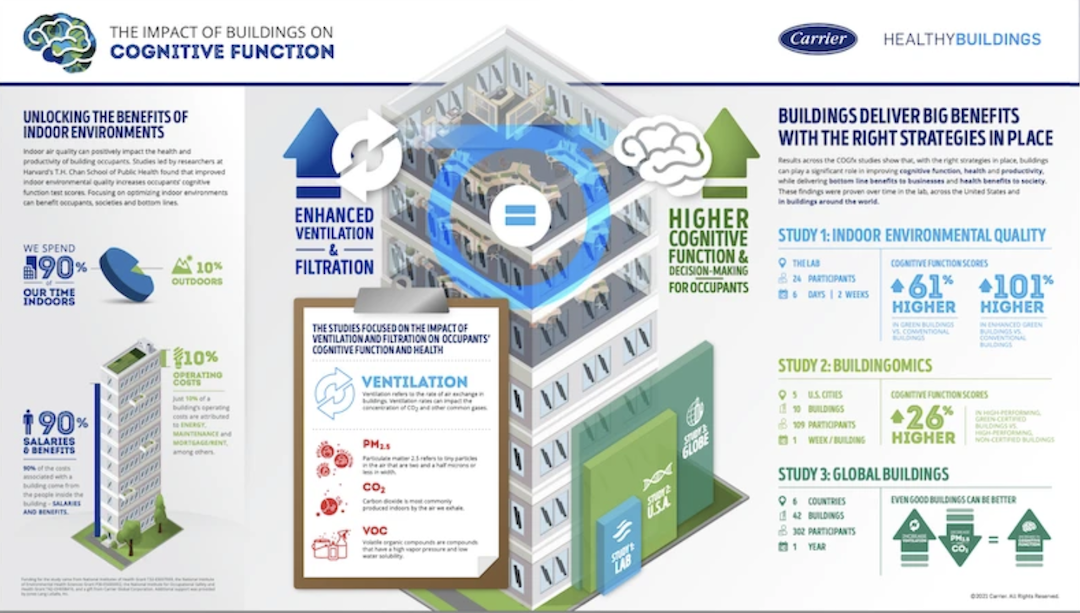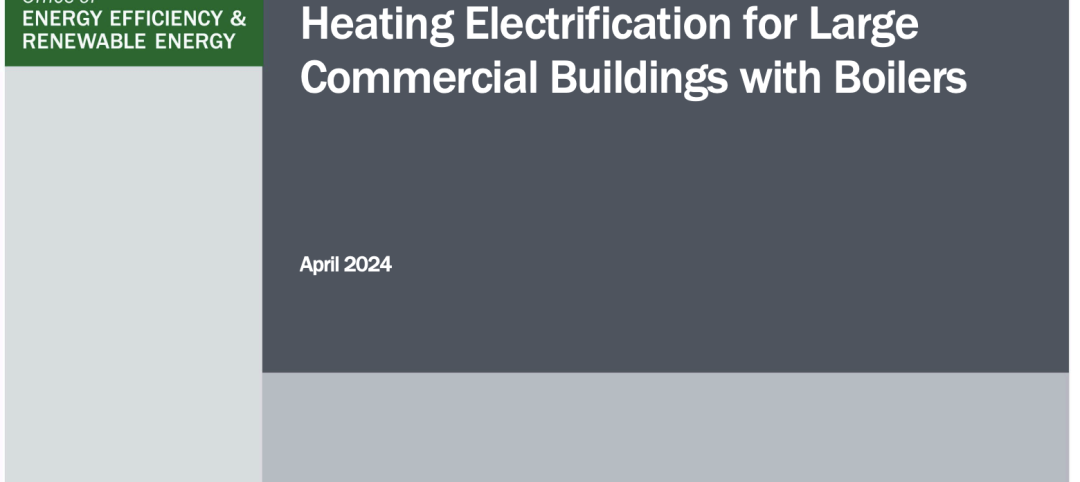Enhanced ventilation and filtration can improve the cognitive function and health of a building’s occupants, and should be the preeminent strategy for healthy buildings.
That’s the conclusion of COGfx Study 3: Global Buildings, new research by the Harvard T.H. Chan School of Global Health, which has been investigating the relationship between indoor air quality and cognitive performance since 2014. The latest study is the first to take a global approach, encompassing 302 office workers in 42 buildings across 30 cities and six countries—China, India, Mexico, Thailand, the United Kingdom, and the U.S.
This study builds upon and corroborates two previous research projects that the T.H. Chan School had conducted over the past several years. The first tested 24 lab workers for six days over two weeks and found 61% higher cognitive scores among those in green vs. conventional buildings, and 100% higher scores in enhanced green buildings. The second tested 109 participants in 10 buildings and five U.S. cities over a week’s time, and recorded 26% higher cognitive scores among those people in green-certified buildings vs. high-performance but non-certified buildings.
The latest, more expansive, study tracked occupant performance over 12 months. The study concluded that occupants’ cognitive function improves by increasing a building’s ventilation (i.e., the rate of air exchange) in ways that reduce its interior inhalable particulates (PM2.5 specifically) and carbon dioxide (CO2)
The third study, whose findings were released last week, used real-time environmental sensors (including wearable monitors) and a customized Harvard Healthy Buildings mobile app to collect data and administer momentary assessments of cognitive function, health, and occupant satisfaction.
IAQ IS NOW CRITICAL TO INTERIOR DESIGN
Even small effects of cognitive function and health can translate into substantive short- and long-term benefits, the study reports. “When you consider that 90% of the costs in a building are associated with the people inside, including salaries and benefits, the ability to improve cognitive performance and reduce infectious disease transmission, sick building symptoms, and missed workdays through improved air quality is powerful.”
As more people return to their workplaces and schools after prolonged pandemic quarantines, “the health, safety, and intelligence of indoor environments have come into greater focus,” says Dave Gitlin, Chairman and CEO of Carrier, the HVAC supplier which provided a gift to help fund this research. “The COGfx Study continues to demonstrate that proper ventilation and filtration of indoor environments play important roles across the globe in fostering a proactive health strategy.”
Carrier’s Healthy Buildings Program, which serves several typologies, offers innovations that include a digital, cloud-native platform for aggregating data from different systems and sensors; OptiClean, a portable negative air machine; and Indoor Air Quality assessments for devising health building strategies.
Funding for the Harvard study also came from the National Institutes of Health, the National Institute of Environmental Health Sciences, and the National Institute for Occupational Safety and Health. JLL provided additional support.
Related Stories
M/E/P Systems | Oct 30, 2024
After residential success, DOE will test heat pumps for cold climates in commercial sector
All eight manufacturers in the U.S. Department of Energy’s Residential Cold Climate Heat Pump Challenge completed rigorous product field testing to demonstrate energy efficiency and improved performance in cold weather.
Smart Buildings | Jul 1, 2024
GSA to invest $80 million on smart building technologies at federal properties
The U.S. General Services Administration (GSA) will invest $80 million from the Inflation Reduction Act (IRA) into smart building technologies within 560 federal buildings. GSA intends to enhance operations through granular controls, expand available reporting with more advanced metering sources, and optimize the operator experience.
Affordable Housing | May 30, 2024
General contractor’s keys to a successful affordable housing project
General contractors can have tremendous influence over a project’s success in terms of schedule, budget, and quality. However, to ensure a project is put on this path, there are a few factors that must be considered.
MFPRO+ New Projects | May 29, 2024
Two San Francisco multifamily high rises install onsite water recycling systems
Two high-rise apartment buildings in San Francisco have installed onsite water recycling systems that will reuse a total of 3.9 million gallons of wastewater annually. The recycled water will be used for toilet flushing, cooling towers, and landscape irrigation to significantly reduce water usage in both buildings.
HVAC | May 28, 2024
Department of Energy unveils resources for deploying heat pumps in commercial buildings
To accelerate adoption of heat pump technology in commercial buildings, the U.S. Department of Energy is offering resources and guidance for stakeholders. DOE aims to help commercial building owners and operators reduce greenhouse gas emissions and operating costs by increasing the adoption of existing and emerging heat pump technologies.
Codes and Standards | May 10, 2024
Guide on electrifying space heating for large commercial buildings with boilers released
The U.S. Department of Energy has released a guide on electrifying space heating for large commercial buildings with boilers. The guide summarizes key considerations for people seeking to retrofit existing large commercial and multifamily buildings, particularly those that currently heat spaces using fossil fuel-fired boilers.
75 Top Building Products | Apr 22, 2024
Enter today! BD+C's 75 Top Building Products for 2024
BD+C editors are now accepting submissions for the annual 75 Top Building Products awards. The winners will be featured in the November/December 2024 issue of Building Design+Construction.
Industrial Facilities | Apr 9, 2024
Confessions of a cold storage architect
Designing energy-efficient cold storage facilities that keep food safe and look beautiful takes special knowledge.
MFPRO+ News | Feb 15, 2024
Nine states pledge to transition to heat pumps for residential HVAC and water heating
Nine states have signed a joint agreement to accelerate the transition to residential building electrification by significantly expanding heat pump sales to meet heating, cooling, and water heating demand. The Memorandum of Understanding was signed by directors of environmental agencies from California, Colorado, Maine, Maryland, Massachusetts, New Jersey, New York, Oregon, and Rhode Island.
75 Top Building Products | Dec 13, 2023
75 top building products for 2023
From a bladeless rooftop wind energy system, to a troffer light fixture with built-in continuous visible light disinfection, innovation is plentiful in Building Design+Construction's annual 75 Top Products report.

















